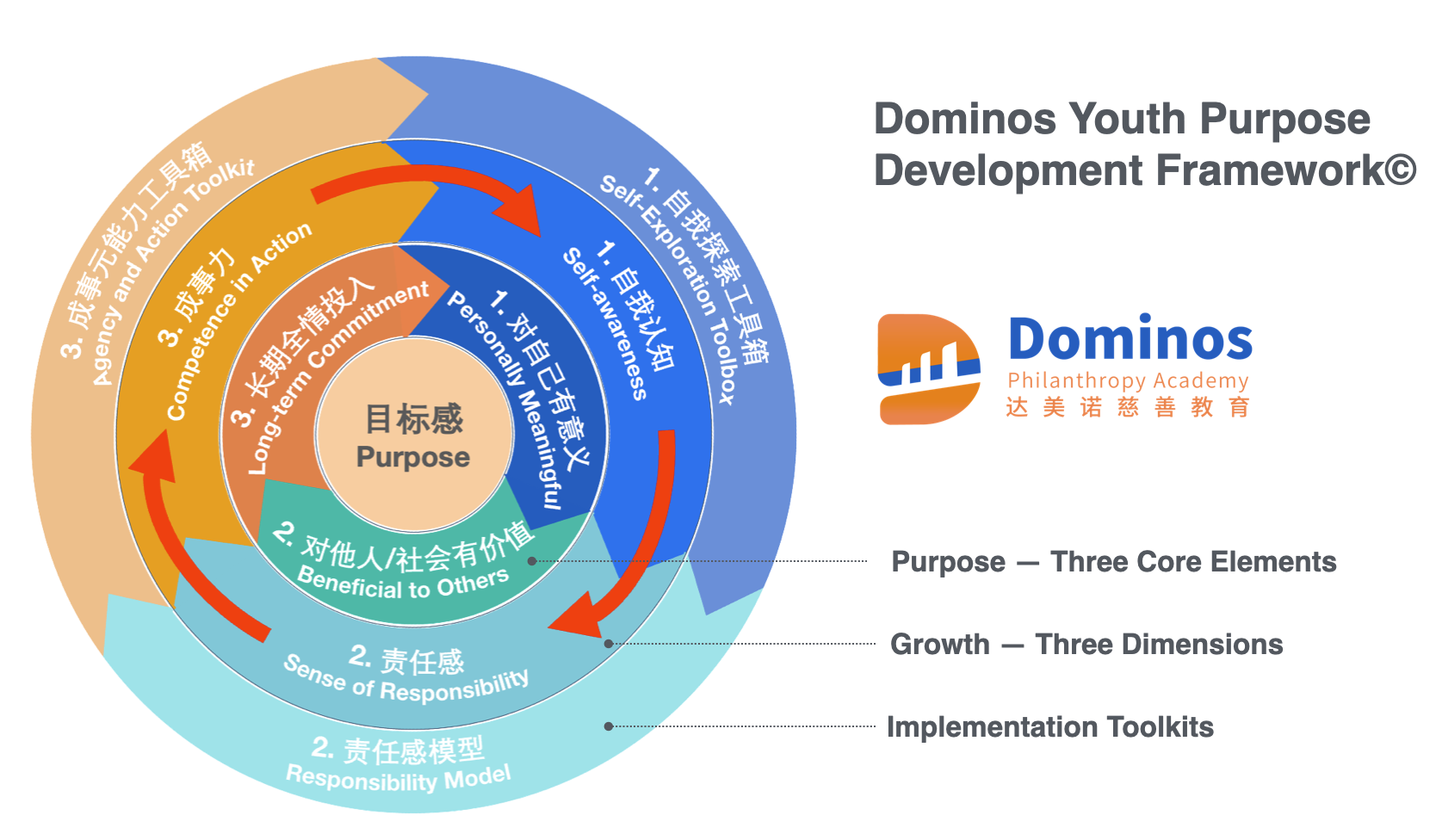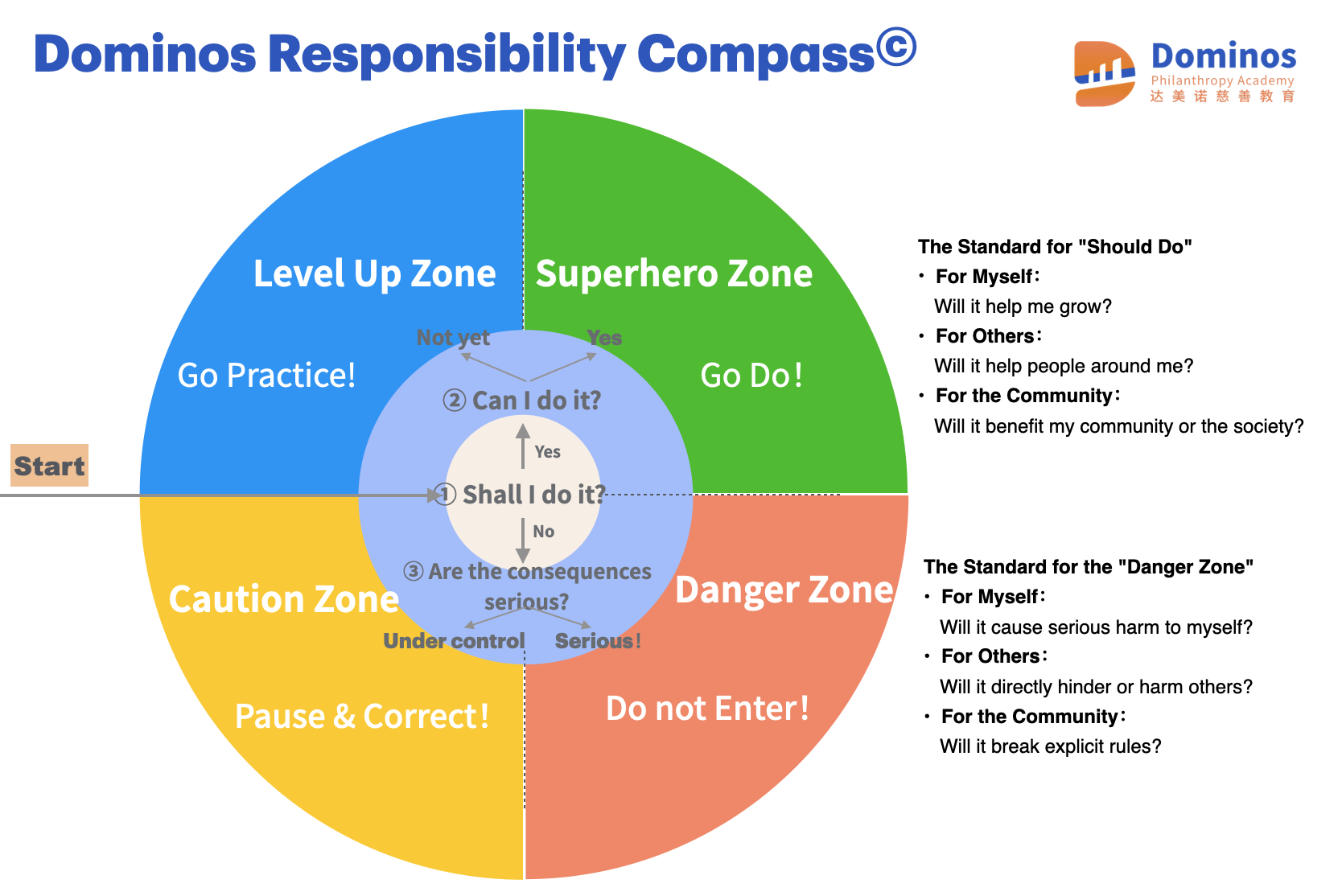“Involution” (内卷), “lying flat” (躺平)—these are not just buzzwords among China’s youth; they are symptoms of a modern challenge that transcends borders: a crisis of meaning. In an educational environment of intense competition, many young people, despite their academic achievements, feel a profound lack of intrinsic motivation and value. They are asking the fundamental question: “What is all this for?”
As educators, we believe the most powerful response to this question lies not in lectures, but in action. We believe the best way to do that is to engineer an authentic experience of what it feels like to have a goal that is bigger than oneself, and to succeed in achieving it.
This is a look at our blueprint for that engineering process.
Our Blueprint: A Self-Reinforcing System for Purpose
Our approach is grounded in the research of Prof. William Damon at Stanford University, who defines a meaningful purpose as having three core components: it is personally meaningful, it contributes to the world beyond the self, and it inspires long-term engagement.

To translate this theory into practice, we developed the Dominos Youth Purpose Framework. Think of it not as a curriculum, but as an “operating system” for growth. This system runs on three practice dimensions, each explicitly designed to cultivate one of the core components of purpose:
- Self-Awareness → The process of discovering what is “personally meaningful.”
- Sense of Responsibility → The journey of connecting with something “beyond the self.”
- Competence in Action (成事力) → The skills that enable “long-term engagement.”
This system is powered by what we call a “dual-value engine.” In every project, students receive two powerful forms of positive feedback: the profound sense of value that comes from helping others, and the empowering sense of achievement that comes from mastering a difficult challenge. This combination ignites a self-reinforcing flywheel of motivation and growth.
The Blueprint in Practice: A Deep Dive into the Pioneer Camp
To show you how this blueprint works, let me take you inside our three-day “Pioneer Camp.” Over three days, students journey from being Learners who explore a social issue on Day 1, to Designers who create an interactive awareness campaign on Day 2, and finally to Actors who take their creations to the public on Day 3. We’ll use our camp focusing on accessibility for people with disabilities as our case study.
1. Cultivating Self-Awareness: From Experience to Insight
We believe self-awareness isn’t just taught; it’s discovered through experience and reflection. Over the three days, 20 students between Grade 4 and Grade 7 are exposed to a wide variety of tasks—research, interviews, hands-on making, public speaking, and teamwork. The “aha” moment comes in a dedicated, half-day reflection session on the final afternoon. Here, we guide them to “connect the dots.”
Using tools like a “Motivation Checklist,” students review their entire journey and identify which activities genuinely excited them. Was it the creative thrill of designing a game? The satisfaction of leading a team discussion? Or the courage found in public speaking? By analyzing these moments, they begin to decode their own inner drivers.
This process can be transformative. One of our campers, Yahan, was described by her mother as an extremely introverted child who, during a preschool trip, once clung to a doorframe, refusing to enter a new space. After several Dominos camps, her mother watched in astonishment as Yahan not only stood confidently on stage, but had also founded her own service club at school. Through reflection, Yahan discovered it wasn’t that she was simply “shy,” but that her motivation was sparked by nurturing others. This is the essence of building self-awareness: moving from a vague experience to a clear, articulated understanding of “what makes me come alive.”
2. Building Responsibility: From Empathy to Actionable Commitment On Day 1, the students’ journey into empathy begins concurrently with inspiration. Led by our co-mentors, one a wheelchair user and the other visually impaired, the students experience the city’s accessibility challenges firsthand. This transforms an abstract issue into a tangible, personal one, sparking a genuine desire to contribute.
To turn this feeling into a commitment, we introduce our “Responsibility Compass.” Here, responsibility is reframed not as a vague moral burden, but as a concrete action, defined as an act you believe you should do and are capable of doing.
It reframes responsibility not as a vague moral burden, but as a concrete action to be practiced. In their daily written reflections, students first apply this tool to their personal and team commitments. One wrote under the “Superhero Zone” (high capability, high responsibility): “I did not slack off; safety first.” Another reflected under the “Level-up Zone” (high responsibility, needs more capability): “I should be more proactive in offering suggestions.”

Through this practice, they begin to see responsibility as an achievable action, not a daunting ideal. This is the crucial bridge that allows them to connect personal responsibility to social responsibility. They realize that while they may not be capable of redesigning the city’s infrastructure, they are capable of raising awareness among their friends and family. Advocating for the issue thus becomes a tangible, achievable act of social responsibility they can own.
3. Forging Competence in Action (成事力): From Good Intentions to Real Impact
A purpose without the ability to act on it is merely a dream. The heart of the camp is about forging Competence in Action (成事力)—the practical skills and resilience to turn intention into impact.
The entire camp is a full Project-Based Learning cycle. This process is intensely challenging. In the final community advocacy event, students’ meticulously designed games malfunctioned, props broke, and they faced waves of public indifference. Our role is not to shield them from this struggle, but to equip them with the tools to overcome it.
This is where our “meta-skills” toolkit comes into play. Students learn to set project milestones, use online documents for collaboration, and practice giving and receiving iterative feedback. Crucially, we teach them the Fogg Behavior Model (B=MAP) as a design tool. They learn to analyze why the public might not want to engage and then brainstorm solutions: How can we make the game more colorful to boost motivation? How can we simplify the rules to lower the barrier to entry?
By navigating these real-world challenges with professional tools, they build a profound belief that they have the capacity to effect change. They learn that purpose is not just about having good intentions, but about having the skills to see them through.
Planting Seeds for a Sustainable Journey
Can a three-day camp give a child a lifelong purpose? Of course not.
Our goal is more fundamental. We aim to provide each student with one complete, powerful, transformative experience of what it feels like to act with purpose. They leave not with a pre-packaged answer, but with something far more valuable: a memory of their own competence, a language to understand their own motivations, and a toolkit for the long journey ahead.
And the journey doesn’t end there. For graduates of the Pioneer Camp, we offer further opportunities to keep their “growth flywheel” spinning through our Champion Camp, where they learn to coach others, and our Ambassador activities, which provide ongoing opportunities for contribution.
In this way, the journey that begins with a single spark in a three-day camp is nurtured into a sustainable flame. It lights a path for the students themselves, and for the communities they are destined to shape.